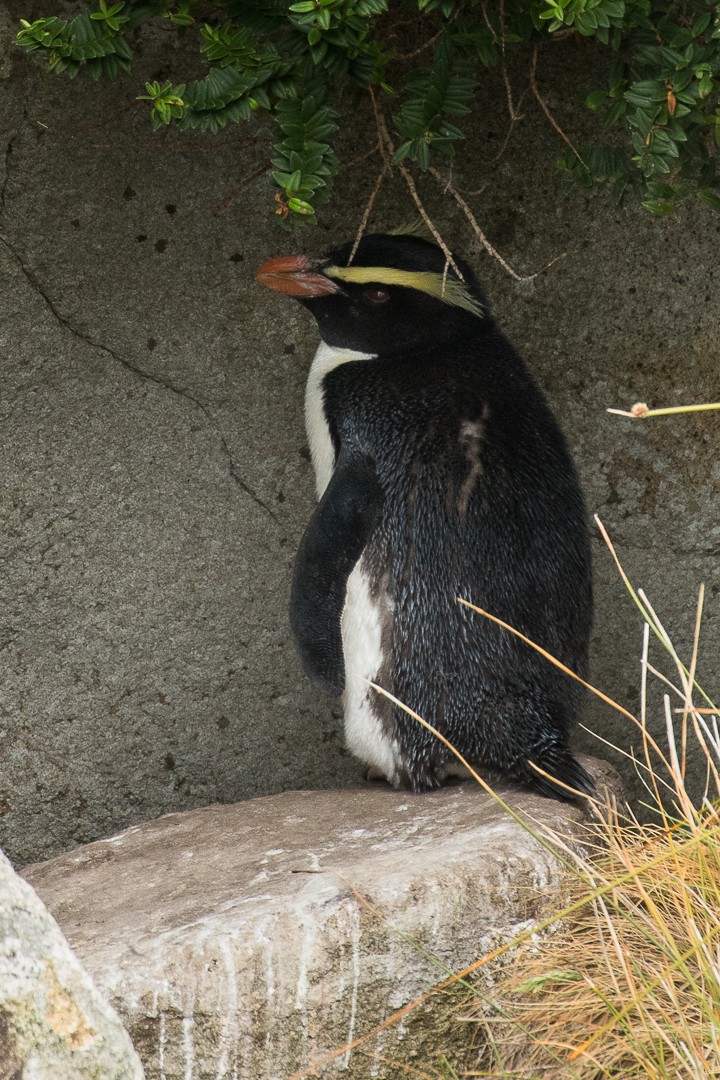Fiordland Penguin
A species of Crested Penguins Scientific name : Eudyptes pachyrhynchus Genus : Crested Penguins
Fiordland Penguin, A species of Crested Penguins
Botanical name: Eudyptes pachyrhynchus
Genus: Crested Penguins
Content
Description General Info
 Photo By Francesco Veronesi , used under CC-BY-SA-2.0 /Cropped and compressed from original
Photo By Francesco Veronesi , used under CC-BY-SA-2.0 /Cropped and compressed from original Description
This species is a medium-sized, yellow-crested, black-and-white penguin, growing to approximately 60 cm (24 in) long and weighing on average 3.7 kg (8.2 lb), with a weight range of 2 to 5.95 kg (4.4 to 13.1 lb). It has dark, bluish-grey upperparts with a darker head, and white underparts. Its broad, yellow eyebrow-stripe extends over the eye and drops down the neck. It can be distinguished from the similar erect-crested penguin (Eudyptes sclateri) and Snares penguin (Eudyptes robustus) in having no bare skin around the base of its bill. Female Fiordland penguins lay a clutch of two eggs where the first-laid egg is much smaller than the second egg, generally hatches later, and shows higher mortality, demonstrating a brood reduction system that is unique from other avian groups. 
Size
71 cm
Life Expectancy
20 years
Nest Placement
Ground
Feeding Habits
Fiordland Penguin's diet consists predominantly of cephalopods, especially arrow squid, with lesser amounts of crustaceans like krill and occasional fish such as red cod and hoki. Fiordland Penguin shows diet variability between locations, adapting feeding behaviors to available marine resources.
Habitat
The fiordland Penguin predominantly inhabits dense temperate coastal forests where it nests in colonies among tree roots and rocks. It is adapted to the broader geographical regions with wet coastal rainforests dominated by native flora such as Weinmannia racemosa and Metrosideros umbellata. This species also occupies nest sites in hollows along rocky coasts. Marine outside the breeding season, fiordland Penguin is likely pelagic and tends to forage closer inshore compared to its congeners.
Dite type
Piscivorous
General Info
Feeding Habits
Bird food type
Distribution Area
This penguin nests in colonies among tree roots and rocks in dense temperate coastal forest. It breeds along the shores the West Coast of the South Island south of about Bruce Bay and the Open Bay Islands, around Fiordland and Foveaux Strait, and on Stewart Island/Rakiura and its outlying islands. Fossils of this species have been found as far north as the northern end of the South Island, and they probably once nested in the North Island as well. Their range has been drastically reduced by hunting in Polynesian times, and they are now only found in the least-populated part of New Zealand. 
Species Status
Fiordland crested penguins are classed as vulnerable to extinction by the IUCN, and their status was changed from vulnerable to endangered by the Department of Conservation in 2013. Surveys in the 1990s counted 2,500 pairs, though this was likely an underestimate; based on historic trends, the population is probably continuing to decline. The main threats are introduced predators such dogs, cats, rats, and especially stoats. They are also vulnerable to human disturbance, fleeing nests and leaving chicks exposed to predators. 
Scientific Classification
Phylum
Chordates Class
Birds Order
Penguins Family
Penguins Genus
Crested Penguins Species
Fiordland Penguin